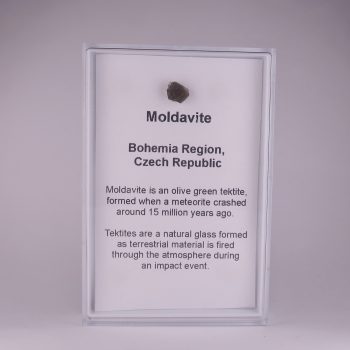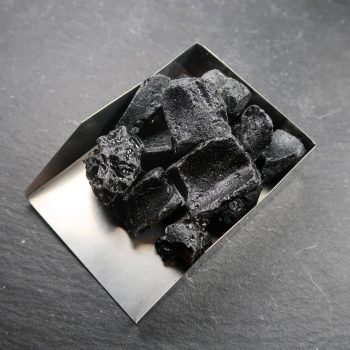Tektites / Impactites
Tektites are a form of natural glass, created by the impact of a meteorite!
They are found worldwide, mostly with a dark brown or black colour – with a few particularly special exceptions with green pieces from the Czech Republic (Moldavite), and yellow pieces in Libya (Libyan Desert Glass).
Showing all 2 results
Appearance, Uses and History
Tektites are small glassy pieces of natural glass formed by terrestrial material being ejected or launched into the upper atmosphere during a meteorite impact – essentially, bits of sand, soil, stone and other Earth material are launched into the sky and melt together.
The chemical composition of Tektites is entirely dependant on the source of the material – as in where the meteorite hit. Due to the different composition, there are many names for Tektites from different locations.
Impactites are an overarching category for materials created by a meteorite impact – not just glass.
Tektites are often confused for glassy slag, or for natural Obsidian, or for man-made glasses, as well as many fake pieces being available on the market.
They are usually around the size of a hazelnut or a walnut, but some large pieces have been found that are up to 13KG.
Locales
Tektite locales include Australia, China, Czechia, Egypt, Ivory Coast, Kazakhstan, Philippines, and the USA, but they could be found anywhere.
Mineralogy
- Australite – a dark, black Tektite from the Australasian strew field, found in Australia.
- Bediasite – a dark brown to black Tektite from the North American strewn field.
- Darwin Glass – a dark green, light green, or dirty brown-black Tektite from the Darwin Crater, found in Australia.
- Georgiaite – a green Tektite from the North American strewn field.
- Indochinite – a dark, black Tektite from the Australasian strew field, found in South East Asia.
- Ivorite – a dark black Tektite from the Ivory Coast strew field.
- Libyan Desert Glass – a golden yellow Tektite found in Libya and Egypt.
- Moldavite – a green Tektite from the European strewn field, found in the Czech Republic.
- Philippinite – a black Tektite from the Australasian strewn field, found in the Phillipines.
Hazards and Warnings
Almost all rocks, minerals (and, frankly, almost all other substances on earth) can produce toxic dust when cutting, which can cause serious respiratory conditions including silicosis.
When cutting or polishing rocks, minerals, shells, etc, all work should be done wet to minimise the dust, and a suitable respirator or extraction system should be used.
Translations
Arabic:
- تكتيت
Hindi:
Portuguese:
Bengali:
Indonesian:
Punjabi:
English:
- tektite
- meteorite glass
Italian:
Russian:
- тектитовых
French:
Japanese:
- テクタイト
Spanish:
- tektita
German:
- Tektit
Korean:
- 텍타이트
Thai:
- สะเก็ดดาว
Gujurati:
Mandarin and Traditional Chinese:
Urdu:
Further Reading / External Links
- https://en.wikipedia.org/wiki/Tektite
- http://www.jsg.utexas.edu/npl/outreach/tektites/
- https://www.meteorite.com/tektite-info-sales/tektite-information/
- http://www.galleries.com/minerals/mineralo/tektites/tektites.htm
- https://meteoritical.org/meteorites/tektites
- https://en.wikipedia.org/wiki/Moldavite
- https://en.wikipedia.org/wiki/Libyan_desert_glass
- https://en.wikipedia.org/wiki/Impactite


